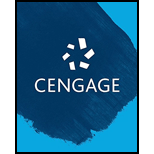
Concept explainers
Interpretation: For a given condition, the pressure should be determined and compared by using
Concept introduction:
By combining the three gaseous laws namely Boyle’s law, Charles’s law and
According to ideal gas law,
Where,
P = pressure in atmospheres
V= volumes in liters
n = number of moles
R =universal gas constant (
T = temperature in kelvins
A modified ideal gas equation on account of molecular size and molecular interaction forces is termed as Van der Waals equation.
That is,
‘a’ and ‘b’ is called Van der Waals coefficient and are characteristic of the individual gas
Where,
P = pressure in atmospheres
V= volumes in liters
n = number of moles
R =universal gas constant (
T = temperature in kelvins
Trending nowThis is a popular solution!

Chapter 5 Solutions
Bundle: Chemistry, Loose-Leaf Version, 10th + OWLv2, 4 terms (24 months) Printed Access Card
- In the text, it is stated that the pressure of 4.00 mol of Cl2 in a 4.00-L tank at 100.0 C should be 26.0 atm if calculated using the van der Waals equation. Verify this result, and compare it with the pressure predicted by the ideal gas law.arrow_forwardPressures of gases in mixtures are referred to as partial pressures and are additive. 1.00 L of He gas at 0.75 atm is mixed with 2.00 L of Ne gas at 1.5 atm at a temperature of 25.0 C to make a total volume of 3.00 L of a mixture. Assuming no temperature change and that He and Ne can be approximated as ideal gases, what are a the total resulting pressure, b the partial pressures of each component, and c the mole fractions of each gas in the mix?arrow_forwardConsider a 5.00-L tank containing 375 g of Ar at a temperature of 25 C. (a) Calculate the pressure in the tank using both the ideal gas law and the van der Waals equation. (b) Which correction term, a(n/V)2 or bn, has the greatest influence on the pressure of this system?arrow_forward
- Shown below are three containers of an ideal gas (A, B, and C), each equipped with a movable piston (assume that atmospheric pressure is 1.0 atm). a How do the pressures in these containers compare? b Are all the gases at the same temperature? If not, compare the temperatures. c If you cooled each of the containers in an ice-water bath to 0.0C, describe how the volumes and pressures of the gases in these containers would compare.arrow_forwardA 1.000-g sample of an unknown gas at 0C gives the following data: P(atm) V (L) 0.2500 3.1908 0.5000 1.5928 0.7500 1.0601 1.0000 0.7930 Use these data to calculate the value of the molar mass at each of the given pressures from the ideal gas law (we will call this the apparent molar mass at this pressure). Plot the apparent molar masses against pressure and extrapolate to find the molar mass at zero pressure. Because the ideal gas law is most accurate at low pressures, this extrapolation will give an accurate value for the molar mass. What is the accurate molar mass?arrow_forwardCalculate the pressure of ethanol vapor, C2H5,OH(g), at 82.0C if 1.000 mol C2H5OH(g) occupies 30.00 L. Use the van der Waals equation (see Table 5.7 for data). Compare with the result from the ideal gas law.arrow_forward
- Nitrogen monoxide gas reacts with oxygen gas to produce nitrogen dioxide gas. What volume of nitrogen dioxide is produced from the reaction of 1 L nitrogen monoxide gas with 3 L oxygen gas? What volume, if any, of the reactants will remain after the reaction ends? Assume all volumes are measured at the same pressure and temperature.arrow_forwardAs 1 g of (lie radioactive element radium decays over 1 year. k produces 1.161018 alpha particles (helium nuclei). Each alpha particle becomes an atom of helium gas. What is the pressure ¡n pascal of the helium gas produced if it occupies a volume of 125 mL at a temperature of 25 C?arrow_forward
 Chemistry: An Atoms First ApproachChemistryISBN:9781305079243Author:Steven S. Zumdahl, Susan A. ZumdahlPublisher:Cengage Learning
Chemistry: An Atoms First ApproachChemistryISBN:9781305079243Author:Steven S. Zumdahl, Susan A. ZumdahlPublisher:Cengage Learning General Chemistry - Standalone book (MindTap Cour...ChemistryISBN:9781305580343Author:Steven D. Gammon, Ebbing, Darrell Ebbing, Steven D., Darrell; Gammon, Darrell Ebbing; Steven D. Gammon, Darrell D.; Gammon, Ebbing; Steven D. Gammon; DarrellPublisher:Cengage Learning
General Chemistry - Standalone book (MindTap Cour...ChemistryISBN:9781305580343Author:Steven D. Gammon, Ebbing, Darrell Ebbing, Steven D., Darrell; Gammon, Darrell Ebbing; Steven D. Gammon, Darrell D.; Gammon, Ebbing; Steven D. Gammon; DarrellPublisher:Cengage Learning Chemistry & Chemical ReactivityChemistryISBN:9781337399074Author:John C. Kotz, Paul M. Treichel, John Townsend, David TreichelPublisher:Cengage Learning
Chemistry & Chemical ReactivityChemistryISBN:9781337399074Author:John C. Kotz, Paul M. Treichel, John Townsend, David TreichelPublisher:Cengage Learning Chemistry & Chemical ReactivityChemistryISBN:9781133949640Author:John C. Kotz, Paul M. Treichel, John Townsend, David TreichelPublisher:Cengage Learning
Chemistry & Chemical ReactivityChemistryISBN:9781133949640Author:John C. Kotz, Paul M. Treichel, John Townsend, David TreichelPublisher:Cengage Learning Chemistry: The Molecular ScienceChemistryISBN:9781285199047Author:John W. Moore, Conrad L. StanitskiPublisher:Cengage Learning
Chemistry: The Molecular ScienceChemistryISBN:9781285199047Author:John W. Moore, Conrad L. StanitskiPublisher:Cengage Learning World of Chemistry, 3rd editionChemistryISBN:9781133109655Author:Steven S. Zumdahl, Susan L. Zumdahl, Donald J. DeCostePublisher:Brooks / Cole / Cengage Learning
World of Chemistry, 3rd editionChemistryISBN:9781133109655Author:Steven S. Zumdahl, Susan L. Zumdahl, Donald J. DeCostePublisher:Brooks / Cole / Cengage Learning





